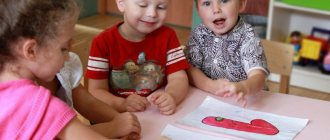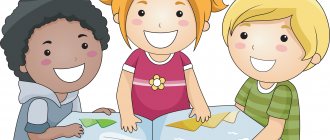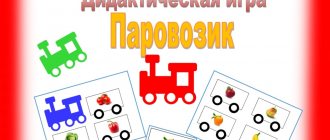The role of theatrical play in the development of speech in preschool children
One of the main tasks of raising and educating preschool children is the task of teaching their native language and speech development. In this direction, in all, without exception, programs for the upbringing and education of children in preschool educational institutions, tasks have been identified for the development of coherent speech of preschoolers and the improvement of all types of games, taking into account the age of the children, and the possibilities for using a variety of games (including theatrical ones) for general development have been revealed. preschoolers. Without the ability to clearly formulate your thoughts, talk figuratively and logically about your experiences, plans, etc., full communication, creativity, self-knowledge and personal self-development are impossible. Therefore, the development of coherent speech and the formation of communication skills is one of the main tasks of kindergarten.
According to the definition of S. L. Rubinstein, “speech is the activity of communication - expression, influence, communication through language. Speech is a form of existence of consciousness (thoughts, feelings) for another, serving as a means of communication with him, and a form of generalized reflection of reality or a form of thinking.
The general task of speech development in preschool children consists of a number of special, private tasks: education of the sound culture of speech; enrichment, consolidation and activation of vocabulary; improving grammatical correctness of speech; formation of conversational (dialogical) and monologue coherent speech, nurturing interest in the artistic word. Of all the speech skills that a child masters in kindergarten, the most difficult for him is the ability to construct a coherent expression. The development of coherent speech (monologue and dialogic) is carried out both during educational activities, in the process of retelling works of art, composing coherent stories from pictures, etc., and during free communication of children with the teacher and peers, as well as in games.
The current stage of development of the preschool education system is characterized by the search and development of new means and methods of teaching and raising children. In this case, the activity-based approach to the child’s personality is used as a priority. The leading activity of preschool children is play. One of the types of games for preschoolers is theatrical play, during which coherent speech is actively formed.
In pedagogical literature, theatrical play is considered not only as a type of play activity, but also as “an effective means of the comprehensive development of children.” (1.166). In the imaginary circumstances of a fairy tale, which most often forms the basis of children's theatrical creativity, the life of people, their customs, the nature of their activities, etc. are reflected in a unique form. In theatrical play, preschoolers comprehend the world around them and get acquainted with the traditions of the peoples of the world. Theatrical games and dramatization games contribute to the development and improvement of all aspects of speech - vocabulary, grammatical structure, and help to master the richness of the native language and its means of expression.
In the book “Imagination and Creativity in Childhood,” psychologist L. S. Vygotsky calls “dramatization, or theatrical production” the most frequent and widespread type of children’s creativity, since “the dramatic form of reflection of life impressions is characteristic of the nature of children and finds its expression spontaneously, independently from the wishes of adults (2, 61).
According to L. S. Vygotsky, theatrical play is an unusually emotionally intense activity. The desire of children to play in a fairy tale brings joy and surprise, which, undoubtedly, is the source of the child’s creativity (2.61). As a source of development of the child’s feelings and deep experiences, theatrical play forms the emotional sphere of the preschool child, who has empathy and the ability to mentally act in imaginary circumstances. Older preschoolers are able to understand the inner world of characters and their contradictory nature, which opens up prospects for using theatrical play in the moral development of a child. Thanks to theatrical play, a preschooler develops and develops social feelings, an emotional attitude towards events and actions that are significant not only for him personally, but also for those around him.
Theatrical games play a large role in the formation of communication skills in preschoolers; they are an effective means of their socialization due to “their understanding of the moral implications of a literary or folklore work and participation in the game, which is of a collective nature, which creates favorable conditions for the development of a sense of partnership and the development of methods positive interaction” (1.24). In the process of dramatization, various communication situations are simulated - a necessary condition for the child’s adaptation in society. In games of the dramatic type, children develop arbitrariness, special sensitivity and attention to the actions of people in life, the ability to see and understand the meaning of a person’s actions, his feelings, relationships with people, nature, etc. (4,6). Finally, “theatrical play is a means of self-expression and self-realization for the child” (1.25).
Researcher I. G. Vechkanova o (4,8). According to L.S. Vygotsky, the aesthetic perception of children during theatrical games “does not come down to a passive statement of known facts” (2, 64). Developing this idea, I. G. Vechkanova emphasizes the specificity of theatrical play as a special type of play activity: it allows not only to introduce the laws of nature, but also to develop the ability to distinguish the world of representation, imagination from reality, the real world (4,5). A special role in this process is played by a work of art - a source and at the same time a material for children's dramatization games. As I. G. Vechkanova writes, “at a certain moment, as a result of upbringing, aesthetic perception gives impetus to the development of the child’s creative activity, since a work of art (visual, musical, literary) not only introduces him to new phenomena and expands the range of his ideas, but also allows him to highlight the essential, characteristic in the subject, to understand the artistic image” (4.9).
In theatrical games, various types of children's creativity develop: artistic speech, musical play, stage play, etc. This is explained by the fact that theatrical play is a comprehensive and synthetic type of activity that combines word, image, music, dance and visual arts. . With an experienced teacher, children strive for an artistic depiction of a literary work not only as “artists” performing roles, but also as “artists” designing the performance, as “musicians” providing sound accompaniment, etc. Therefore, according to the authors, “ Preschool pedagogy” by S. A. Kozlova and T. A. Kulikova, “the possibilities of introducing preschool children to creative artistic activities in the process of preparing a theatrical game and its course are extremely high” (5, 305).
E. Belous claims that theatrical games contribute to the development and improvement of all aspects of preschoolers’ speech - vocabulary, grammatical structure, coherent speech, and help master the richness of their native language and its expressive means. (6.66).
For children of different age groups, theatrical play has its own characteristics. Thus, the main goal of working with children of primary preschool age is to develop interest in theatrical games, which develops in the process of watching small puppet shows that the teacher shows, taking as a basis the content of nursery rhymes, poems and fairy tales familiar to the child.
The child’s gradual transition from observing an adult’s theatrical production to independent play activities; from individual play and “side-by-side play” to play in a group of three to five peers playing roles; from imitation of the actions of folklore and literary characters to imitation of actions in combination with the transfer of the main emotions of the hero and mastering the role as the creation of a simple image in a dramatization game.
By older preschool age, the theatrical and play experience deepens due to the development of different types of dramatization games and director's theatrical play. This process consists of children becoming more active and independent in choosing the content of games, and being creative in their choice. Older preschoolers have access to independent performances, including those based on a “collage” of several literary works (3, 31). They have more complex texts for productions that are distinguished by a deeper moral meaning and hidden subtext. The theatrical play uses Russian folk tales and fables about animals (“The Fox and the Crane”, “The Hare and the Hedgehog”), works from the alphabet by L. N. Tolstoy, fables by I. A. Krylov, short fairy tales by H. H. Andersen, humorous stories by N. Nosov and others.
In this regard, an important aspect of the teacher’s activity is the expansion of play experience through the development of varieties of dramatization games. The implementation of this task is achieved by successively complicating game tasks and dramatization games in which the child is included.
O. Akulova divides the system of work on the development of theatrical play into three stages.
The first stage is devoted to deepening the artistic perception of a literary text (3.25). The goals of the work are determined, this includes - enriching cognitive and emotional experience on the theme and idea of the work; educational activities on cognitive and speech development of children; work on the artistic means of a work of visual and musical activity in accordance with the content of the work. This work involves familiarization with the text (conversations, looking at book illustrations, listening and analyzing audio recordings, didactic games, lexical exercises, etc.).
At the second stage, the development of skills to convey images using means of non-verbal, intonation and linguistic expressiveness appears; the main method of its implementation is figurative and playful sketches.
The third stage is associated, according to O. Akulova, with the child’s creativity in speech, play and other types of artistic activity in the process of mastering the playing positions of “spectator”, “artist”, “scriptwriter-director”, “designer-costumer”. This work can be implemented in the process of visual activity (collective drawing of posters, making invitations) (3.32). Work organized in this way contributes to the fact that theatrical play becomes a means of self-expression and self-realization of the child in various types of creativity, a source of self-affirmation in a group of peers. At the same time, the life of preschool children in kindergarten will be enriched due to the integration of games and various types of art, which are embodied in theatrical and play activities.
In the process of theatrical play, preschoolers' dialogic speech improves, since a new role (especially the dialogue of characters) confronts the preschooler with the need to express himself clearly, clearly and understandably (7.112).
Theatrical games contribute to the development of monologue speech. This work is closely related to teaching a variety of techniques for children to retell the works that are recommended to them. Retelling fairy tales, short stories, and poems makes it possible to improve the spoken monologue (and dialogical, if it is a retelling in person) speech of children (8.6–7). By retelling a literary text, on the basis of which the dramatization game will be built, preschoolers master the expressive means of language ( comparisons, personification, metaphors, synonyms, antonyms, etc.).
O. Safonova believes that the activation of children’s speech in the game is facilitated by “the opportunity to transform with the help of costumes and makeup, the use of scenery, surprise moments, etc.” If at the beginning of training only individual episodes of a fairy tale are acted out, then by the end of preschool childhood you can dramatize the entire fairy tale. And here “children can take the initiative themselves, taking on the role they like and acting out the action without the help of a teacher” (9.57).
The essence of the above comes down to the fact that theatrical play is one of the most effective ways of developmental influence on a child, in which the principle of learning is most clearly manifested: to learn by playing.
Literature:
- Novoselova S. L. Game of a preschooler / ed. S. L. Novoselova. - M.: Education, 1989.
- Vygotsky L. S. Imagination and creativity in childhood / L. S. Vygotsky. - St. Petersburg: Soyuz, 1997. - 61–64 p.
- Akulova O. Theatrical games / O. Akulova.// Preschool education. - 2005. - No. 4. - 24–25 p.
- Vechkanova I. G. Theatrical games in habilitation of preschool children with intellectual disabilities / I. G. Vechkanova. - St. Petersburg: KARO, 2006. -5–10 p.
- Kozlova S. A. Preschool pedagogy /S. A. Kozlova, T. A. Kulikova. - M.: Academy, 2002.305 p.
- Belous E. Development of speech and phonemic hearing in theatrical and play activities / E. Belous // Preschool education. 2009. — No. 7.66–70с.
- Slepovich E. S. Play activities of preschoolers / E. S. Slepovich. - M.: Education 1989. 112 p.
- Makhaneva M. D. Theatrical activities of preschool children / M. D. Makhaneva // Preschool education. - 1999. - No. 11. 6–7 p.
- Smirnov E. The influence of puppet theater on the development of children / E. Smirnov // Preschool education. - 1981. - No. 6. 81–83 p.
Theatrical activities as a means of developing dialogical speech in preschool children
One of the main tasks of the speech development of preschool children is the mastery of dialogical speech, since it is in its depths that coherent speech is born. One cannot but agree that speech is a means of communication and an instrument of thinking; arises and develops only in the process of communication.
The word “dialogue” is one of many foreign words that is currently widely used in the Russian language. It comes from the Greek word dialogas and means “conversation”, “conversation”. We share the point of view of researchers who point out that dialogue depends on the situation, on the context of the conversation, is determined by the previous statements of the interlocutors, is often unplanned, is implemented in the process of direct communication and consists of alternating remarks. T. G. Vinokur in his work “On some syntactic features of dialogic speech in the modern Russian language” highlights the following linguistic features of dialogue: a more or less fast pace of speech, when each component is a replica; comparative brevity of remarks; brevity and ellipticity of constructions within replicas; syntactic incompleteness, etc.
There is no doubt that dialogue is a form of social interaction, and in order for a preschooler to take part in dialogue, he must master certain skills:
1. Speech skills themselves (know when, how and with whom to communicate; how to continue and end a conversation).
2. Speech etiquette skills (a preschooler gradually learns to greet, say goodbye, invite, ask, congratulate, thank, refuse, etc., this is how he masters speech cliches and some template figures of speech).
3. Nonverbal skills (the child learns to use gestures, facial expressions, and postures correctly and appropriately).
Teachers are constantly looking for ways to develop dialogical speech in preschoolers; many agree that theatrical activities are an effective methodological tool for this. It should be noted that there are different points of view on theatrical activity, its varieties and the system of work for the development of theatrical activity.
According to the definition of O. A. Karabanova, theatrical activity is the deliberate reproduction of a separate plot of the script.
According to I. G. Vechkanov, theatrical activities reflect age, gender, and social relationships; obeys the plot or scenario (in its temporal and spatial characteristics); the created images are materialized (by dressing up, using dolls, masks, etc.); various symbolic means are used (facial expressions and pantomime, graphics, intonation, singing, etc.).
Theatrical activity, as noted by L. S. Vygotsky, N. Ya. Mikhailenko, D. B. Elkonin, is close to both a plot game and a game with rules. I. G. Vechkanova points out that theatrical activity is set by a work of art or a pre-agreed plot of reality. He notes that the role requires greater subordination to the plot from the preschooler (when compared with role-playing games), but does not exclude creativity.
Thus, theatrical activity is both a type of artistic activity (where there is an integration of literature, music, and visual arts) and a plot game (manifested in the child’s creative experience).
The organization and methodology of theatrical activities are widely represented in the works of teachers and methodologists - L. Voroshnina, L. Bochkareva, I. Medvedeva, T. Shilova, etc. Their studies note that theatrical activities stimulate active speech, expand vocabulary, and help to assimilate wealth native language, is a source of development of feelings and non-verbal elements of communication.
Researchers (N. Karpinskaya, A. Nikolaicheva, L. Furmina, etc.) note that thanks to theatrical activities, preschoolers learn about the world around them through the knowledge of heroes, the study of images and characters; The issues raised in theatrical productions force children to think, draw conclusions and generalizations. Theatrical activities contribute to the formation of the experience of social interactions, since every literary work for preschool children has a moral orientation. Positive heroes of fairy tales become role models, negative characters cause condemnation .
Traditionally, theatrical activities are divided into two groups: role-playing (dramatization) and directing (see Diagram 1).
In role-playing actions, the child plays a role, realizes a certain image, based on this image (positive or negative), the child’s subsequent actions follow, since the hero of the work can be sad and cheerful, cunning and naive, and the child must try to express these feelings, emotions and character traits verbally and nonverbally. Each played image is internally studied by the child and remembered. Role-playing activities include: imitations of images, role-playing dialogues, performances and improvisations.
In director's actions, the child is not an actor, but directs toys, dolls, and substitute objects, voices them, comments on the plot, and creates a play space. Preschoolers reproduce dialogues from fairy tales, works, or invent their own. Types of director's actions: tabletop, puppet, plane theaters, toy theaters, etc.
Rice. 1.
Traditionally, preparation for theatrical activities is carried out in several stages.
First stage: perception of the work. First, it is necessary to introduce preschoolers to a literary or folklore work, have a conversation about what they read, explain the content, and identify characters with different character traits.
The second stage: identifying parts in the work, clarifying the motives of the characters’ actions.
Third: musical and rhythmic accompaniment (selection of musical works that will be played in the performance).
Fourth: work on costumes and scenery.
Fourth: working on parts of the work, rehearsing individual parts.
Fifth: rehearsal with costumes for the entire performance.
Sixth: premiere of the play.
Seventh: preparation of drawings based on the performance, discussion of the performance, exhibition of photographs (with speech comments). This is how children learn to evaluate performance and understand that the final result depends on everyone.
In the methodological literature, I highlight the following methods for enhancing children’s participation in theatrical activities: allowing the preschooler to choose a role at will; cast a shy child in the lead role; distribute roles on cards.
The teacher must have special skills in organizing theatrical activities. To teach a child to express the feelings and emotions of a character, the teacher must be able to read expressively, since the teacher’s intonation is a role model. The teacher must be able to transform, that is, have artistic qualities. Must be able to organize, lead, i.e. have directorial skills; create attributes, elements of costumes, masks, scenery that can help preschoolers feel the characters and the environment created in the performance. The teacher must introduce children to theatrical culture: introduce them to the theater, its structure, its types, in order to develop an interest in theatrical art.
So, theatrical activity can be classified as a means of developing dialogical speech, since through it children develop the ability to use various types of remarks: they learn to competently ask a question and answer it in accordance with the topic and situation (in detail or briefly); learn to communicate their opinions, impressions, emotions to their interlocutor, learn to be tolerant of other opinions. Basic rules of behavior in dialogue are formed (listen to the interlocutor, speak in turns, etc.).
Thus, with the help of theatrical activities, the child expresses his thoughts, his attitude to what he saw, to what he read; The preschooler reports his impressions, shares his feelings, which contributes to the development of speech abilities. Any literary and folklore work is an example of dialogic interaction. Memorizing literary dialogues, staging poems, and role-playing nursery rhymes enrich the speech of preschoolers with forms of dialogical remarks; children remember the rules of dialogue; they form an idea of the participants (addressees and addressees) of the dialogue.
Literature:
1. Akulova, O. Theatrical games [Text] /O. Akulova // Preschool education. - 2005. - No. 4. - P. 24–26.
2. Artemova, L. M. Theatrical games of preschoolers [Text] / L. M. Artemova. - M.: Education, 1991. - 128 p.
3. Arushanova, A. Organization of dialogical communication between preschoolers and peers [Text] / A. Arushanova // Preschool education. - 2000. - No. 4. - P. 91–93.
4. Migunova, E. V. Organization of theatrical activities in kindergarten [Text]: textbook. method. Manual / E. V. Migunova. - Veliky Novgorod: Publishing house of Novgorod State University named after. Yaroslav the Wise, 2006. - 198 p.
5. Mikhailova, A. Ya. Child in the world of theater [Text]: a methodological manual for workers of preschool institutions / A. Ya. Mikhailova. - M., 2001. - 80 p.
6. Solntseva, O. Playing story games [Text] /O. Solntseva // Preschool education. - 2005. - No. 4. - P. 34–37.
7. Yurina, N. N. Theatrical activities in kindergarten [Text] / N. N. Yurina // Aesthetic education and development of preschool children / ed. E. A. Dubrovskaya, S. A. Kozlova. - M., 2002. - 208 p.








